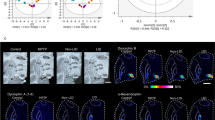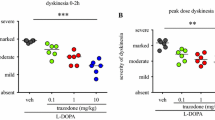Summary
Aged common marmosets were treated with 1-methyl-4-phenyl-1,2,3,6-tetrahydropyridine (MPTP; 0.5–2.0 mg/kg/week i.p.) for 16 or 24 weeks, observed for a total of 30 weeks and then killed for measurement of biochemical pramaters in basal ganglia. The MPTP treatment induced a marked depletion in dopamine, 3,4-dihydroxyphenylacetic acid and homovanillic acid levels in the caudate nucleus and putamen. In contrast, the concentrations of five neuropeptides: [Met5]-enkephalin, [Leu5]-enkephalin, cholecystokinin, substance P and neurotensin as measured by a combined HPLC/RIA method, remained unaltered in all basal ganglia regions examined. Enkephalin precursor levels, as reflected by cryptic [Met5]-enkephalin content, were increased in the putamen, but not in the caudate nucleus, as a consequence of MPTP administration. Cryptic [Leu5]-enkephalin content remained unchanged in the striatum of MPTP treated marmosets. Overall, these results suggest an increase in striatal [Met5]-enkephalin release following chronic MPTP treatment of aged marmosets. However, the chronic treatment of aged marmosets with MPTP does not reproduce the neuropeptide alterations characteristic of Parkinson's disease.
Similar content being viewed by others
References
Agid Y, Javoy-Agid F (1985) Peptides and Parkinson's disease. Trends Neurosci 6: 30–35
Allen JM, Cross AJ, Yeats JC, Ghatei MA, McGregor GP, Close SP, Pay S, Marriott AS, Tyers MB, Crow TJ, Bloom SR (1986) Neuropeptides and dopamine in the marmoset. Effect of treatment with 1-methyl-4-phenyl-1,2,3,6-tetrahydropyridine (MPTP): an animal model for Parkinson's disease? Brain 109: 143–157
Angulo JA, Davis LG, Burkhart BA, Christoph GR (1986) Reduction of striatal dopaminergic neurotransmission elevates striatal proenkephalin mRNA. Eur J Pharmacol 130: 341–343
Bissette G, Nemeroff CB, Decker MW, Kizer JS, Agid Y, Javoy-Agid F (1985) Alterations in regional brain concentrations of neurotensin and bombesin in Parkinson's disease. Ann Neurol 17: 324
Burns RS, Chiueh CC, Markey SP, Ebert MN, Jacobowitz DM, Kopin IJ (1983) A primate model of parkinsonism; selective destruction of dopaminergic neurons in the pars compacta of the substantia nigra by N-methyl-4-phenyl-1,2,3,6-tetrahydropyridine. Proc Natl Acad Sci 80: 4546–4550
Cupo A, Pontarotti PA, Jarry Th, Delaage M (1984) A new immunological approach to the detection and the quantitation of the Met5-enkephalin precursors in rat brain. Neuropeptide 4: 375–387
De Ceballos ML, Boyce S, Taylor M, Jenner P, Marsden CD (1987) Age-related decreases in the concentration of Met-and Leu-enkephalin and neurotensin in the basal ganglia of rats. Neurosci Lett 75: 113–117
Forno LS, Langston JW, Delanney LE, Irwin I (1988) An electron microscopic study of MPTP-induced inclusion bodies in an old monkey. Brain Res 448: 150–157
Grafe MR, Forno S, Enge LF (1985) Immunocytochemical studies of substance P and met-enkephalin in the basal ganglia and substantia nigra in Huntington's, Parkinson's and Alzheimer's disease. J Neuropathol Exp Neurol 44: 47
Hornykiewicz O (1980) Biochemical abnormalities in some extra-striatal neuronal systems in Parkinson's disease. In: Rinne UK, Kingler M, Stamm G (eds) Parkinson's disease: current progress, problems and management. Elsevier/North Holland, Amsterdam, pp 107–120
Jenner P, Rupniak NMJ, Rose S, Kelly E, Kilpatrick G, Lees A, Marsden CD (1984) 1-Methyl-4-phenyl-1,2,3,6-tetrahydropyridine-induced parkinsonism in the common marmoset. Neurosci Lett 50: 85–90
Jenner P, Taquet H, Mauborgne A, Benoliel JJ, Cesselin F, Rose S, Javoy-Agid F, Agid Y, Marsden CD (1986) Lack of change in basal ganglia neuropeptide content following subacute 1-methyl-4-phenyl-1,2,3,6-tetrahydropyridine treatment of the common marmoset. J Neurochem 47: 1548–1551.
Jiang H-K, McGinty JF, Hong JS (1990) Differential modulation of striatonigral dynorphin and enkephalin by dopamine receptor subtypes. Brain Res 507: 57–64
Liston D, Patey G, Rossier J (1984) Processing of proenkephalin is tissue-specific. Science 225: 734–736
Sivam SP, Breese GR, Krause JE, Napier TC, Mueller RA, Hong JS (1987) Neonatal and adult 6-hydroxydopamine-induced lesional differentially alter tachykinin and enkephalin gene expression. J Neurochem 49: 1623–1633
Smith Y, Parent A (1986) Differential connections of caudate nucleus and putamen in the squirrel monkey (Samiri Sciureus). Neuroscience 18: 347–371
Taquet H, Javoy-Agid F, Mauborgne A, Benoliel JJ, Agid Y, Legrand JC, Hamon H, Cesselin F (1987) Brain neuropeptides in progressive supranuclear palsy. Brain Res 411: 178–182
Taquet H, Nomoto M, Rose S, Jenner P, Javoy-Agid F, Mauborgne A Benoliel JJ, Marsden CD, Legrand JC, Agid Y, Hamon M, Cesselin F (1988) Levels of MET-enkephalin, LEU-enkephalin, substance P and cholecystokinin in the brain of the common marmoset following long term 1-methyl-4-phenyl-1,2,3,6-tetrahydropyridine treatment. Neuropeptides 12: 105–110
Vernier P, Julien JF, Rataboul P, Fourrier O, Feuerstein C, Mallet J (1988) Similar time course changes in striatal levels of glutamic acid decarboxylase and proenkephalin mRNA following dopaminergic deafferentation in the rat. J Neurochem 51: 1375–1380
Wagner J, Vitali P, Palfreyman MG, Zraika M, Huol S (1982) Simultaneous determination of 3,4-dihydroxyphenylalanine, 5-hydroxy-tryptophan, dopamine, 4-hydroxy-3-methoxyphenylalanine, norepinephrine, 3,4-dihydroxyphenyl-acetic acid, homovanillic acid, serotonin and 5-hydroxyindoleacetic acid in rat cerebrospinal fluid and brain by high performance liquid chromatography with electrochemical detection. J Neurochem 38: 1241–1254
Waters CM, Peck R, Rossor M, Reynold GP, Hunt SP (1988) Immunocytochemical studies on the basal ganglia and substantia nigra in Parkinson's disease and Huntington's chorea. Neuroscience 25: 419–438
Young SW, Bonner TI, Brann MR (1986) Mesencephalic dopamine neurons regulate the expression of neuropeptides mRNAs in the rat forebrain. Proc Natl Acad Sci USA 83: 9827–9831
Zamir N, Skofitsch G, Bannon MJ, Helke CJ, Kopin IJ, Jacobowitz DM (1984a) Primate model of Parkinson's disease: alterations in multiple opoid systems in the basal ganglia. Brain Res 322: 356–360
Zamir N, Palkovitz M, Weber H, Mezey E, Brownstein MJ (1984b) A dynorphinergic pathway of Leu-enkephalin production in substantia nigra. Nature 307: 643
Author information
Authors and Affiliations
Rights and permissions
About this article
Cite this article
Taylor, M.D., de Ceballos, M.L., Rose, S. et al. Neuropeptide levels in the basal ganglia of aged common marmosets following prolonged treatment with MPTP. J Neural Transm Gen Sect 3, 99–108 (1991). https://doi.org/10.1007/BF02260885
Received:
Accepted:
Issue Date:
DOI: https://doi.org/10.1007/BF02260885




